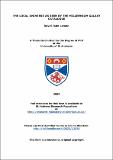The local universe as seen by the Millennium Galaxy Catalogue
Abstract
In this thesis we construct a B-band catalogue of the local universe which we call the Millennium Galaxy Catalogue (MGC). The MGC is photometrically and astrometrically accurate to +/-0.03 mags and +/-0.08" respectively and covers an area of~ 36 sq deg in the NGP. Colour and redshift information are available from overlapping regions of the two-degree Field Galaxy Redshift Survey (2dFGRS) and the Sloan Digital Sky Survey Early Data Release (SDSS-EDR). With an exposure time of 750s and an isophotal surface brightness limit of 26 mags/sq arcsecs, the MGC is the largest and deepest photometric survey of the local universe to-date.
As well as containing photometric information, by making use of a newly developed software package-Galaxy Image 2D (GIM2D), and assuming a standard de Vaucouleurs and exponential galaxy profile, the MGC also contains structural parameters (half light radius and (B/T) etc) to all galaxies in the magnitude range 16 < BMGC < 20.
By making use of the information in the MGC we are able to classify our galaxies into three morphological types (E/SO, Sabc and Sd/Irr) using (B/T) cuts. In doing this we find that 30.52% of the galaxies form a "new" galaxy population identified by having a (B/T) of exactly 0. After visual inspection this population is found to be a mixture of early and late type star-forming Spirals and Irregular galaxies, all of which have a disk component that is flatter than an exponential. After visually redistributing these galaxies we find that the local galaxy population consists of 28.1% E/SO, 39.64% Sabc and 31.37% Sd/Irr.
From the redshift information contained within the MGC we are able to look at the galaxy distribution in terms of physical parameters. We find that the galaxies are distributed in absolute magnitude, surface brightness and half light radii in a manner that is consistent with the hierarchical formation scenario.
We derive total and morphological galaxy number counts and, after combining them via a step wise maximum likelihood (SWML) technique, we arrive at morphological LFs. From examining the galaxy counts we find that there is no steep rise in the bright end, eradicating the need for strong local evolution. Also one does not need to renormalise the morphological or total galaxy counts in order for them to be consistent with faitner counts. The Sabc and Sd/Irr LFs are surprisingly similar with both showing a mild faint end slope.
We look at the properties of bulges and disks of galaxies. We find that as galaxies become more diskey there bulges move away from the Kormendy law for Elliptical galaxies.
Due to the similarity of the Spiral and Irregular population LFs, as well as apparent and intrinsic parameter distributions, we are forced to conclude that one can only reliably distinguish between the Ellipticals and the general galaxy population, and that investigating the bulge and disk components of a galaxy may be more useful than Hubble types.
Type
Thesis, PhD Doctor of Philosophy
Collections
Items in the St Andrews Research Repository are protected by copyright, with all rights reserved, unless otherwise indicated.

